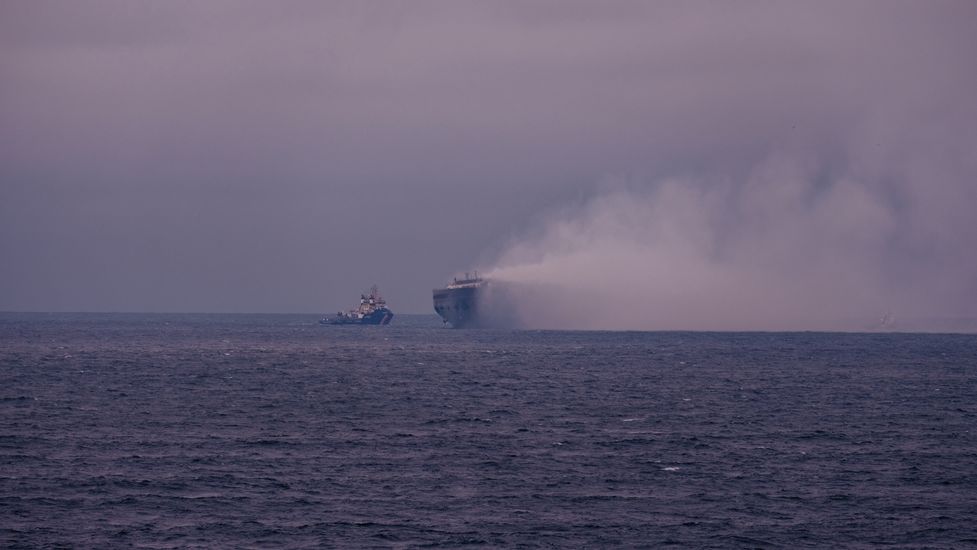The number of battery-powered mobile cargo handling machines in ports is increasing and is forecast to grow steadily as higher-powered Lithium-ion batteries become more affordable and emissions limits tighten further. On internal combustion engine (ICE) container handling equipment (CHE), such as reach stackers, it has been reported that up to 90% of fires are caused by hydraulic oil leaking from hoses and valves onto hot engine parts (Firetrace International).
For electric vehicles (EVs), fires are often more complex and can be more serious. Take the incident on the PCTC Fremantle Highway. It caught fire off the Dutch coast in late July 2023 and was ablaze for more than a week before being salvaged and towed to Zeebrugge. The ship was carrying around 3,800 cars of which around 500 were new EVs according to the cargo manifest.
At a TT Club webinar last October, experts from Brookes Bell described how the ship’s canopy deck was “blown outwards” by 2.5m on a length of 100m by the force of a vapor cloud explosion from the top car deck. This was caused by a substantial release of hydrogen and noxious gases from the EVs.
It is understood that up to 6,000l of gases can be vented for every 1 kWh of installed battery power. The car decks just melted away as temperatures soared above 600°C, the melting point of aluminum.
This point is taken up by Sweden-based Dafo Vehicle Fire Protection AB, a leading provider of vehicle fire suppression systems with more than 24,000 references worldwide. ICE fires take longer to heat to the maximum temperature of around 600°C and thereafter they decay relatively quickly. In contrast, an EV fire can result in temperatures increasing to 1,200°C very quickly and it then takes much longer for the fire to decay.
It is estimated that 500-1,000 gallons of water can extinguish an ICE vehicle fire in around 30 mins, whereas an EV fire typically requires 30,000 gallons of water for four hours. Even if that was possible on a car carrier, such as Fremantle Highway, the amount of water sloshing around on the open decks would quickly destabilize it. That’s assuming you can even get to the fire in tightly parked stows (which you can’t) and in any case the batteries are sealed above the chassis.
Nitrogen extinguishers are recommended for ships carrying EVs. NOVEC 1230 is also recommended, but it contains PFAs that are now banned in many jurisdictions. Early warning gas detectors also need to be fitted.
Less stable
While many industries are familiar with FLTs and warehouse equipment powered by lead-acid batteries, Dafo Vehicle makes the point that these machines are much more stable than those installed with Lithium-ion batteries. The latter are chemically more complex and pack much more energy into a smaller space. Volatility and energy density mean a greater risk of fires occurring and more serious ones at that.
While not minimizing the dangers of ICE fires, those involving EVs and hybrid machinery with Lithium-ion batteries are of a different order of magnitude and require a new approach. Battery failure through short circuiting, overcharging, high temperatures, mechanical damage or overheating, leads rapidly to thermal runaway and the release of flammable electrolytes in the tightly packed cells. In turn, this results in a chain reaction emitting highly toxic fumes and gases.
As previously discussed in WorldCargo News, working with RISE (the Swedish Research Institute), Dafo Vehicle developed SaFEV. This comprises ForrexEV, a new version of its well-known Forrex (now PFA-free) suppressant, a digital monitoring system that includes a carbon monoxide sensor to detect telltale gas release and a control unit that immediately shuts everything down.
Dafo Vehicle product manager, Anders Gullikssson, makes the point that off-road EVs present added problems compared to, say, buses. In China, electric bus fires were frequently caused by collisions as the batteries were placed at the back. Nowadays, they are out of harm’s way on the roof.
The location on cargo handling equipment, however, is determined where there is space to fit them and the battery packs may be in different places on the same machine, including being used as a counterweight.
OEM role
Business segment manager at Dafo Vehicle, Fredrik Rosén, says the quality of the OEM’s battery management system (BMS) is of crucial importance as it adjusts current and voltage in real-time. Rigorous battery quality control during production and testing is obviously required, but there could still be internal flaws that build up to a crisis point after a period of use. Some battery makers have been forced to withdraw products and conduct even more rigorous testing.

The optimum charge level of a battery is generally between 20% and 70%. This not only prolongs life, but also reduces stress damage that can lead to a fire. Overcharging increases the risk of a fire while undercharging can lead to gases being generated and result in a noxious vapour cloud. “Deep” discharging also impairs charging capability. OEMs often install software to ensure the machine shuts down automatically if the charge falls below a certain level.
Any type of battery can catch fire, although at the TT Club webinar it was stated that NCA (nickel, cobalt, aluminium) types start to self-heat and undergo thermal runaway at a relatively low temperature of 150 degC. The threshold for LFP (Lithiumion phosphate) and LMO (Lithium manganese oxide) is higher at around 250 degC. LFP has the lowest rate of heat generation at 20 degC/minute.
Commenting on another car carrier fire, that of the Felicity Ace, Gulliksson stated that purely from a fire safety standpoint, EVs should be stowed much further apart and each one should be covered by an EV fire blanket. Obviously, this would destroy the economics of PCTCs as far as EVs are concerned.
For shipping purposes, EVs are classed as UN3171/IMDG Class 9. If they were reclassed as IMDG 4.3 (flammable solids), container transportation would, in effect, be mandatory.
A special container with steel racking (higher melting point than aluminium), insulation and built-in CCTV and gas and heat sensors would be needed. EV transportation could become much more expensive and perhaps uneconomical other than for top end, luxury cars.
Understanding the risk
For Dafo Vehicle, the key point is that the magnitude of the risks associated with EV fires is not properly understood by the logistics chain and equipment users. Fire experts recommend that burning vehicles are isolated in a steel bin and covered with a tarpaulin to starve the fire of oxygen. How can you do that with, say, an electric reach stacker?
To promote understanding and reduce risks, Dafo Vehicle has introduced a new “Safety Solution” concept. “This approach,” says Hannu Sartuovo, VP, Sales & Marketing, “looks at the whole supply chain, expanding beyond hardware provision and focusing on how best to raise awareness.”
Services entail thorough fire risk analysis for both equipment itself and its operating environment, facilitating a customized system design to mitigate identified risks effectively. System delivery encompasses comprehensive coverage for detection, alarm, suppression, and control needs. Tailored training programmes cater to specific requirements, including fire risk management, operator extinguishing techniques, emergency response planning, and considerations for electric and hybrid vehicles, enhancing operational safety.
“Post-sales support,” says the company, “guarantees swift all-year-round call-out service for service and maintenance and readily available spare parts, ensuring continuous reliability and peace of mind for port operators. This holistic approach elevates safety standards, safeguarding both equipment and personnel within port environments.”
The company’s Safety Solution is based on site visits and in-person conversations so that Dafo Vehicle’s experts can understand the local infrastructure and environment and provide detailed assessments to operations management and drivers. The fire risk analysis will be made with the port company and detailed assessments will be provided to operations management and drivers.
You just read one of our articles for free
To continue reading, subscribe to WorldCargo News
By subscribing you will have:
- Access to all regular and exclusive content
- Discount on selected events
- Full access to the entire digital archive
- 10x per year Digital Magazine
SUBSCRIBE or, if you are already a member Log In
Having problems logging in? Call +31(0)10 280 1000 or send an email to customerdesk@worldcargonews.com.





